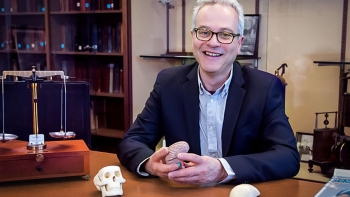ASU researcher on how understanding vulnerabilities to addiction could inform treatments

iStock image
September is National Recovery Month, and though there are many evidence-based treatments available for substance-use disorders, they do not work for everyone.
According to the National Institute on Drug Abuse, the rate of relapse for people in recovery from drug addiction in the U.S. is 40–60%.
One of the ways NIDA is working to improve recovery success is by funding research to uncover what makes people vulnerable to addiction.
Arizona State University’s Jonathan Gewirtz, professor and associate chair of psychology, is part of a nationwide, NIDA-funded consortium of researchers who study genetic sources of vulnerability to addiction and recovery.
Gewirtz, who has been studying the biological mechanisms involved in addiction for nearly 25 years, explains how researchers identify the vulnerabilities to becoming addicted and how the findings could help inform improved treatments for substance-use disorders.
Question: Why are some people more vulnerable to addiction than others?
Answer: Every kind of characteristic or trait — such as height, eye color or personality — is the result of the mixture of our genetic makeup with our environment. The influence of genes on mental illness, which includes addiction, is high — at about 50%. Our environment includes our life experiences, such as our home life, family dynamics, how much stress is in our lives and much more. Some people are more vulnerable because of their genes, and others are more vulnerable because of circumstance.
Vulnerability also varies by drug. Opioids are the most potent and therefore very addictive, but they are harder to access than alcohol and tobacco, which are addictive but legal.
Q: How does an individual’s environment affect the influence of genes?
A: Though everything about us — what makes us human — is initially determined by our genes, the trajectory that we take depends upon our interaction with the world. These interactions can include life experiences such as whether we have a disease, take drugs, experience stress or benefitted from great parenting. The cross-talk between our genes and life experiences determines the effects that our genes have.
In other words, our life experiences do not affect our genetic code; the instructions that are coded in our DNA remain the same for our entire life. But, our life experiences can alter gene expression, or how the instructions coded in our DNA are carried out. This phenomenon is called epigenetics.
Q: What are some ways to identify vulnerabilities?
A: One way is to look at the entire genome, which is the complete set of DNA instructions for an organism, and then search for genetic variants that are associated with addiction. This is difficult and requires extremely large datasets, such as the UK Biobank, which includes complete genomes from 500,000 people.
Another way is to study how genes are expressed using animal models. My lab studies a mechanism (called) gene transcription — the first step in the production of proteins — and then we test the impact of different environmental scenarios. We can look at the effects of early exposure to drugs and relapse on gene expression and at differences between individuals. We look at patterns across the entire genome.
Gene expression is controlled by the structure of chromatin, which is like the scaffolding for packaging DNA into chromosomes. We can use the shape of chromatin to track which genes are likely to be expressed. When chromatin is relaxed, or in an “open” state, the genes in that region of DNA are active or poised to become active.
Our research on identifying vulnerabilities to addiction has led to the findings that opioid exposure affects networks of genes responsible for myelination in the brain. Myelin is a molecule that acts like the insulation on electrical wires, and it helps neurons communicate effectively. Opioid exposure down-regulates, or suppresses, expression of gene networks that are associated with myelination.
Q: How does understanding individual differences in vulnerability to addiction help inform treatments or prevention strategies?
A: The goal is some form of individualized medicine, tailored to an individual’s specific vulnerabilities, that could result in screening and knowing how effective specific treatments would be.
Right now, we do not have great treatments for addiction, especially for opioid addiction. We have “maintenance” therapy for opioid addiction in which patients take methadone; however, methadone does not work for everyone. This line of research could lead to the identification of a network of genes that might help with diagnoses or knowing who should not be receiving narcotic painkilling drugs.
Another way that understanding vulnerabilities might inform treatments or prevention strategies is knowing which protective processes in the brain to promote. For example, maybe it is possible that drugs that affect myelination could confer some resilience against addiction.
More Science and technology

4 ASU researchers named senior members of the National Academy of Inventors
The National Academy of Inventors recently named four Arizona State University researchers as senior members to the prestigious organization.Professor Qiang Chen and associate professors Matthew…

Transforming Arizona’s highways for a smoother drive
Imagine you’re driving down a smooth stretch of road. Your tires have firm traction. There are no potholes you need to swerve to avoid. Your suspension feels responsive. You’re relaxed and focused on…

The Sun Devil who revolutionized kitty litter
If you have a cat, there’s a good chance you’re benefiting from the work of an Arizona State University alumna. In honor of Women's History Month, we're sharing her story.A pioneering chemist…


